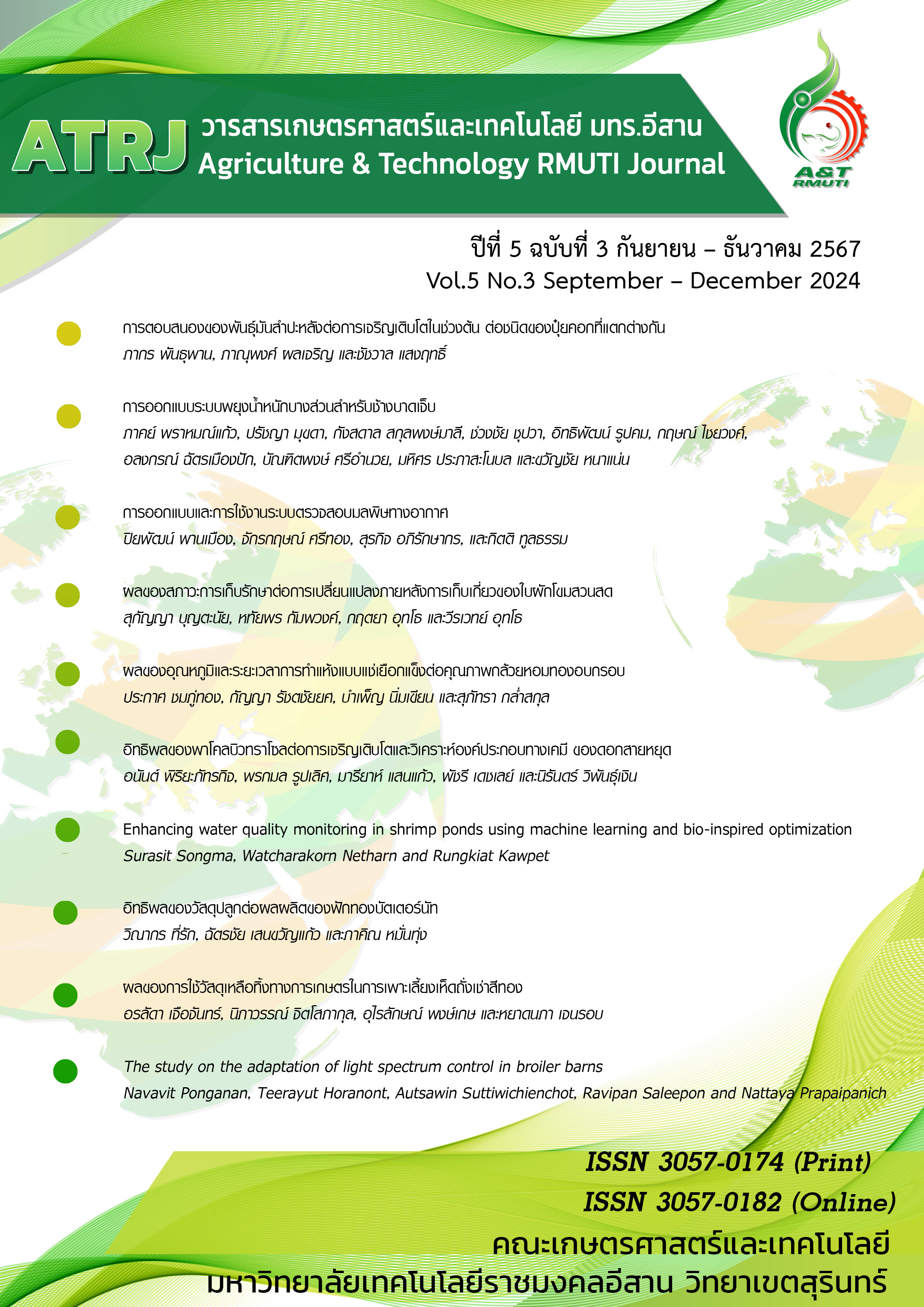Enhancing water quality monitoring in shrimp ponds using machine learning and bio-inspired optimization
Keywords:
Water quality, Shrimp ponds, Machine learning, Bio-inspired optimization techniquesAbstract
This work investigates how to improve water quality monitoring in shrimp ponds by combining machine learning and bio-inspired optimization techniques. Preprocessing the dataset is crucial before applying and evaluating classifiers like LR, DT, RF, SVM, KNN, NB and GBC against water quality indicators. Using criteria such as accuracy, precision, recall, F1-score and AUC, as well as computational aspects like as model size and CPU time, the study concludes that the RF model is clearly superior. It is further enhanced using approaches such as EBAO, EACO, ECBOA and EPSO, resulting in significant gains in prediction performance, particularly precision and recall. Among optimization methodologies, EACO stands out for striking a balance between performance enhancement and computing efficiency. The results highlight the importance of merging machine learning with bio-inspired algorithms in environmental monitoring, demonstrating a compelling methodology for improving water quality management in aquaculture. This complete approach not only enhances the precision of water quality assessments in shrimp farming but also establishes a precedent for future applications in environmental science and technology.
References
Agarwal T. and Kumar V. (2022). A systematic review on bat algorithm: Theoretical foundation, variants, and applications. Archives of Computational Methods in Engineering. 29(5): 2707-2736.
Ahmed U., Mumtaz R., Anwar H., Shah A.A., Irfan R. and Garcí-Nieto J. (2019). Efficient water quality prediction using supervised machine learning. Water. 11: 2210. https://doi:10.3390/w11112210.
Ali A., Razak A.S., Othman S.H., Eisa, T.A.E., Al-Dhaqm A., Nasser M., Elhassan T., Elshafie H. and Saif A. (2022). Financial fraud detection based on machine learning: A Systematic Literature Review. Applied Sciences. 12: 9637. https://doi.org/10.3390/app12199637.
Azargashb L.S., Hashemy S.S.M. and Roozbahani A. (2021). Minimization of operational and seepage losses in agricultural water distribution systems using the ant colony optimization. Water Resources Management. 35(3): 827-846.
Dorigo M. and Blum C. (2005). Ant colony optimization theory: A survey. Theoretical Computer Science. 344(2–3): 243-278.
Fan C., Chen M., Wang X., Wang J. and Huang B. (2021). A review on data preprocessing techniques toward efficient and reliable knowledge discovery from building operational data. Frontiers in Energy Research. 9: 652801. https://doi.org/10.3389/fenrg.2021.652801.
Gad A.G. (2022). Particle swarm optimization algorithm and its applications: A systematic review. Archives of Computational Methods in Engineering. 29(5): 2531-2561.
Gakii C. and Jepkoech J. (2019). A Classification model for water quality analysis using decision tree. European Journal of Computer Science and Information Technology. 7(3): 1-8.
Guenther N. and Schonlau M. (2016). Support vector machines. The Stata Journal. 16(4): 917-937.
Hernández J.J.C., Fernández L.P.S. and Pogrebnyak O. (2011). Assessment and prediction of water quality in shrimp culture using signal processing techniques. Aquaculture International. 19(6): 1083-1104.
Ilić M., Srdjević Z. and Srdjević B. (2022). Water quality prediction based on Naïve Bayes algorithm. Water Science and Technology. 85(4): 1027-1039.
Islam K.M.S., Islam N., Uddin J., Islam S. and Nasir M.K. (2022). Water quality prediction and classification based on principal component regression and gradient boosting classifier approach. Journal of King Saud University-Computer and Information Sciences. 34(8): 4773-4781.
Javaid M., Haleem A., Pratap S.R., Suman R. and Rab S. (2022). Significance of machine learning in healthcare: Features, pillars and applications. International Journal of Intelligent Networks. 3: 58-73.
Kajornkasirat S., Ruangsri J., Sumat C. and Intaramontri P. (2021). Online analytics for shrimp farm management to control water quality parameters and growth performance. Sustainability. 13: 5839 https://doi.org/10.3390/su13115839.
Krhoda G.O. and Owira A.M. (2019). Groundwater quality prediction using logistic regression model for Garissa County. Africa Journal of Physical Sciences. 3: 13-27.
Laoong-U-thai Y., Wanna W. and Kaikaew A. (2022). DNA binding activity of marine shrimp LvProfilin. Applied Science and Engineering Progress. 15(3): 5522. https://doi.org/10.14416/j.asep.2021.10.002
Lukman H., Na S. and Liris M. (2023). Combining generative model and random forest to predict shrimp disease occurrence. Proceedings of the International Conference on Fisheries and Aquaculture. 10(1): 35-44.
Nuanmeesri S., Poomhiran L., Kadmateekarun P. and Chopvitayakun S. (2023). Improving the water quality classification model for various farms using features based on artificial neural network. TEM Journal. 12(4): 2144-2156.
Poian D.V., Theiling B., Clough L., McKinney B., Major J., Chen J. and Hörst S. (2023). Exploratory data analysis (EDA) machine learning approaches for ocean world analog mass spectrometry. Frontiers in Astronomy and Space Sciences. 10: 1134141. https://doi.org/10.3389/fspas.2023.1134141.
Ridzuan F. and Wan Z.W.M.N. (2019). A review on data cleansing methods for big data. Procedia Computer Science. 161: 731-738.
Shami T.M., El-Saleh A.A., Alswaitti M., Al-Tashi Q., Summakieh M.A. and Mirjalili S. (2022). Particle swarm optimization: A comprehensive survey. IEEE Access. 10: 10031-10061.
Somantri M., Herawati V.E., Sofwan A., Abdurrasyiid H. and Arfan M. (2018). Design of water quality control for shrimp pond using senso-cloud integration. In Proceeding of 2018 5th International Conference on Information Technology, Computer and Electrical Engineering (ICITACEE). Semarang, Indonesia. 331-335
Songma S., Sathuphan T. and Pamutha T. (2023). Optimizing intrusion detection systems in three phases on the CSE-CIC-IDS-2018 Dataset. Computers. 12(12): 245 https://doi.org/10.3390/computers12120245.
Tohka J. and van Gils M. (2021). Evaluation of machine learning algorithms for health and wellness applications: A tutorial. Computers in Biology and Medicine. 132: 104324. https://doi.org/10.1016/j.compbiomed.2021.104324
Uddin S., Haque I., Lu H., Moni M.A. and Gide E. (2022). Comparative performance analysis of K-nearest neighbour (KNN) algorithm and its different variants for disease prediction. Scientific Reports. 12: 6256. https://doi.org/10.1038/s41598-022-10358-x.
Wang Y. and Han Z. (2021). Ant colony optimization for traveling salesman problem based on parameters optimization. Applied Soft Computing. 107: 107439. https://doi.org/10.1016/j.asoc.2021.107439.
Yang X.S. and Deb S. (2009). Cuckoo search via Lévy flights. In 2009 World Congress on Nature & Biologically Inspired Computing (NaBIC). Coimbatore. India. 210-214.
Downloads
Published
How to Cite
Issue
Section
License
Copyright (c) 2024 Agriculture & Technology RMUTI Journal

This work is licensed under a Creative Commons Attribution-NonCommercial-NoDerivatives 4.0 International License.
เนื้อหาและข้อมูลในบทความที่ลงตีพิมพ์ในวารสารทดสอบระบบ ThaiJo2 ถือเป็นข้อคิดเห็นและความรับผิดชอบของผู้เขียนบทความโดยตรงซึ่งกองบรรณาธิการวารสาร ไม่จำเป็นต้องเห็นด้วย หรือร่วมรับผิดชอบใดๆ
บทความ ข้อมูล เนื่อหา รูปภาพ ฯลฯ ที่ได้รับการดีพิมพ์ในวารสารทดสอบระบบ ThaiJo2 ถือเป็นลิขสิทธิ์ของวารสารทดสอบระบบ ThaiJo2 หากบุคคลหรือหน่วยงานใดต้องการนำทั้งหมดหรือส่วนหนึ่งส่วนใดไปเผยแพร่หรือเพื่อกระทำการใดๆ จะต้องได้รับอนุญาตเป็นลายลักอักษรณ์จากวารสารทดสอบระบบ ThaiJo2 ก่อนเท่านั้น






